| English / Deutsch | Print version |
| Prev Table of Contents - Plop Boot Manager Six - PBM6 |
Table of Contents | Next PBM6 - EFI |
PBM6 - BIOS/Legacy
The Plop Boot Manager Six (PBM6) is a new boot manager. It is still a test release, so be careful. Find more information in the Development Blog.
This page is about the BIOS/Legacy version. See next page for EFI.
| 1. Download |
| 2. Screenshots |
| 3. Manual |
| 4. PC Speaker |
| 5. pbm6-dos.exe |
1. Download
Donations are rare and welcome: Donate
pbm6-20240901.zip (latest) Notes see here
pbm6-20240901-serial.zip Special release with serial console support. Notes see here
pbm6-20240301.zip
pbm6-20240301-serial.zip
pbm6-20230818.zip
pbm6-20230818-serial.zip
pbm6-test-20221118.zip
pbm6-test-20221118-serial.zip
pbm6-test-20221104.zip
pbm6-test-20221104-serial.zip
pbm6-test-20220719.zip
pbm6-test-20220719-serial.zip
pbm6-test-20220627.zip
pbm6-test-20220529.zip
pbm6-test-20220506.zip
pbm6-test-20220409.zip
pbm6-test-20210909.zip
pbm6-test-20210119.zip
pbm6-test-20200420.zip
pbm6-test-20200408.zip
pbm6-test-20200319.zip
2. Screenshots
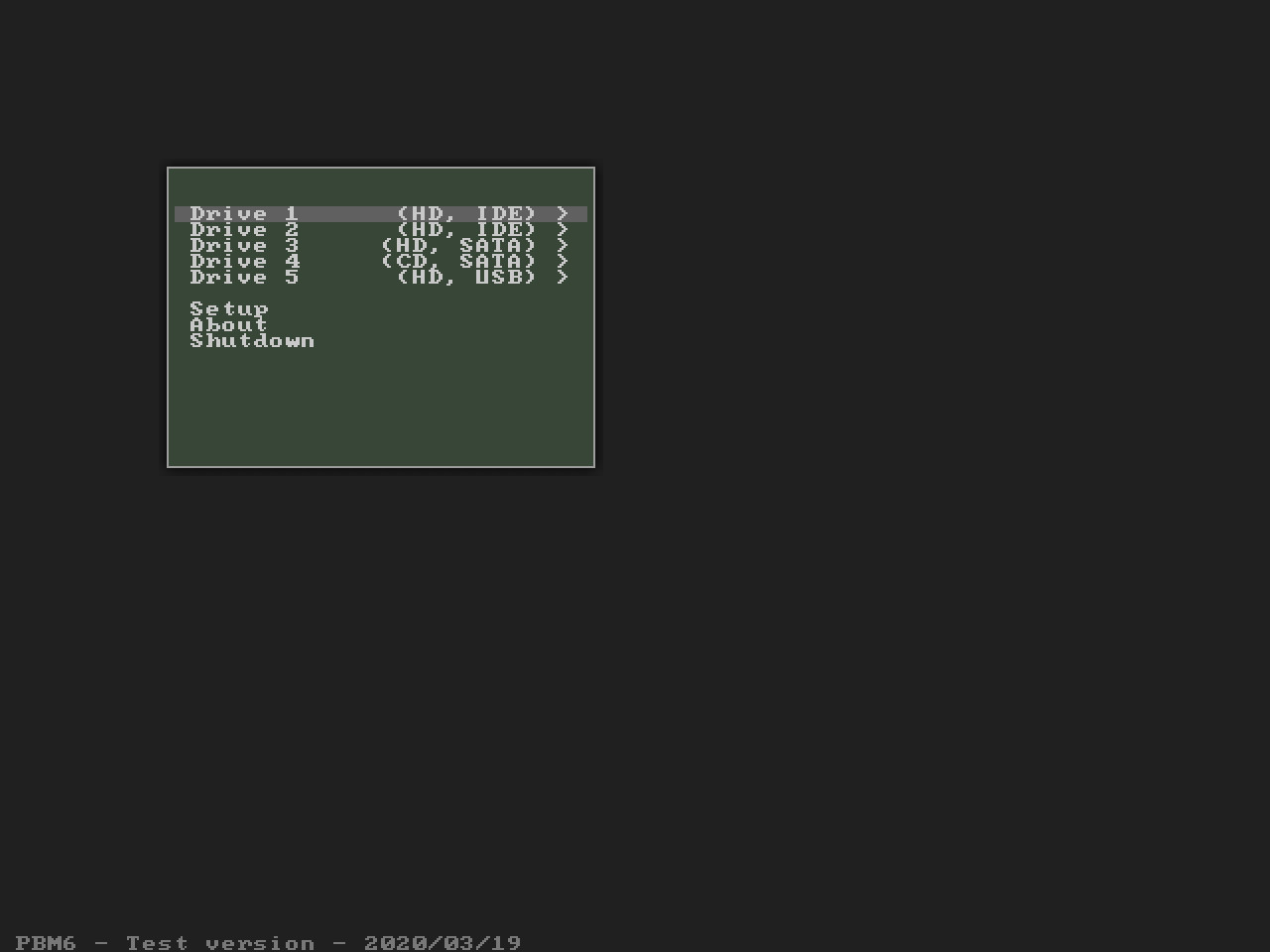
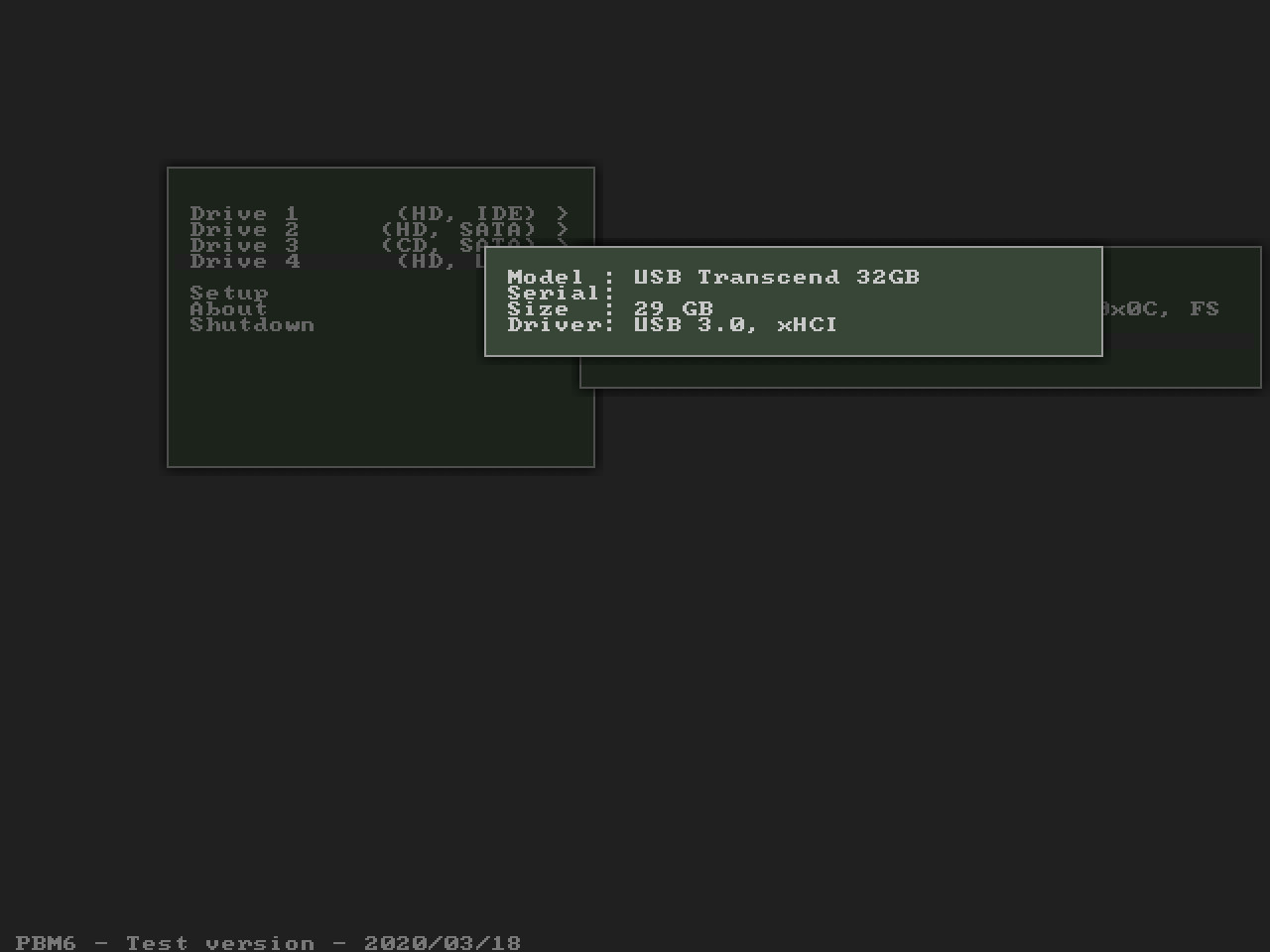
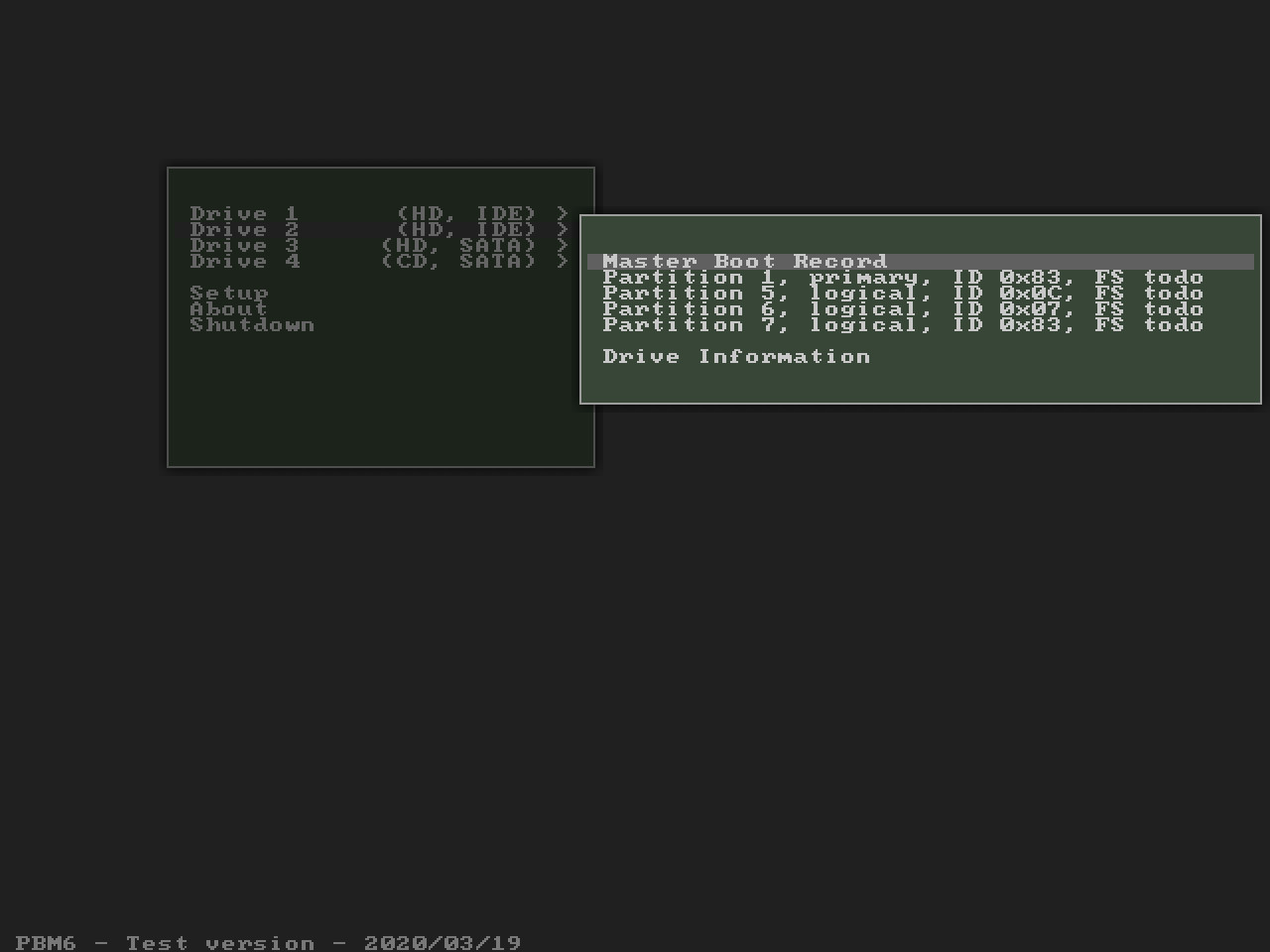
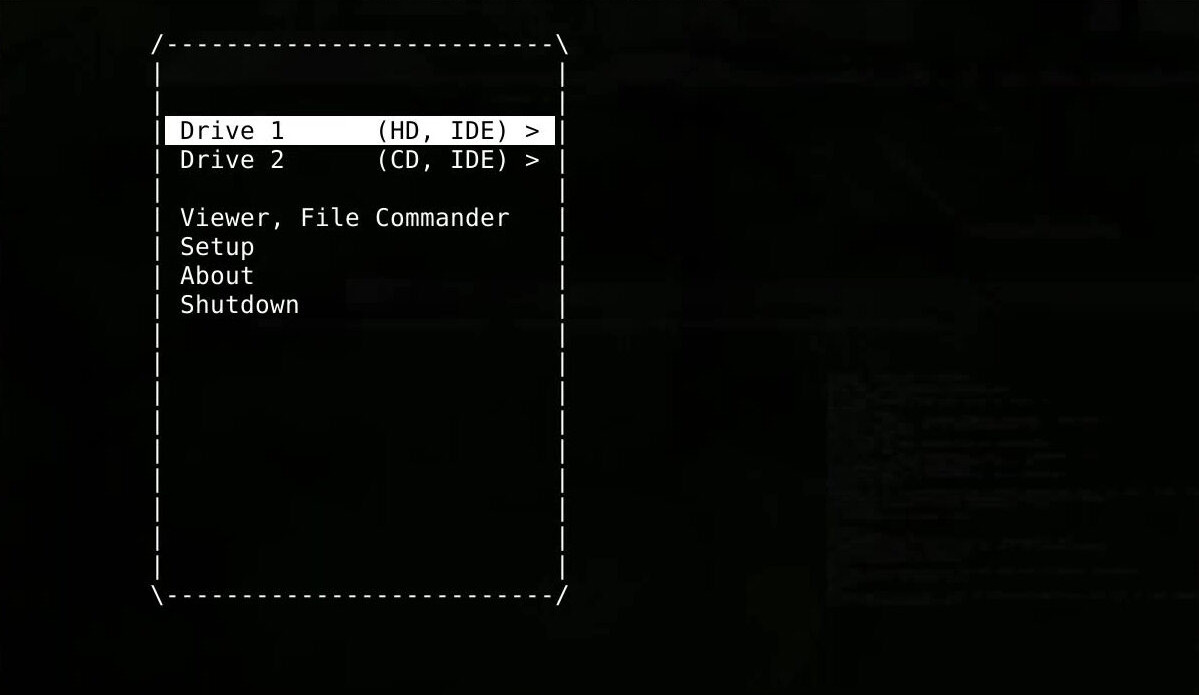
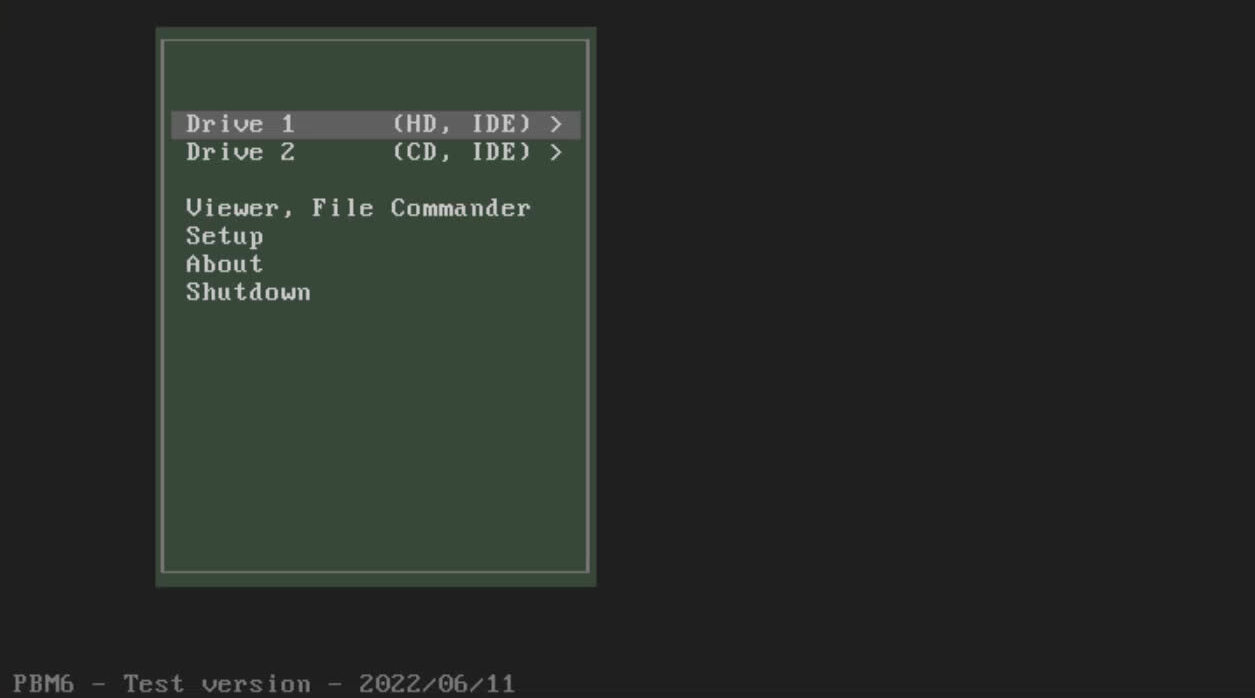
3. Manual
Known issues: A lot, its a test release. find more information in the Development Blog.
What should work:
- IDE: Hard disks, CD/DVD drives.
- SATA: Hard disks, CD/DVD drives.
- USB Controller: USB 1.1 UHCI/OHCI, USB 2.0 EHCI, USB 3.0 xHCI support.
- USB Device support for keyboard, HUB, thumb drives, hard disks, CD/DVD drives.
- USB read/write support.
- USB Hot-Plug.
- Boot drive partition.
- Start drive MBR.
- Boot CD/DVD in no-emulation mode.
- Eject CD/DVD.
- Show drive details.
- Change screen resolution, also wide screen.
- Start PMB6 from Floppy, CD/DVD drive, network, Linux Boot Managers, Windows Boot Menu (Vista/7/8/10).
- Morse codes with PC Speaker.
- VHD/VHDX mount and boot.
- Viewer: Hex and text view. View sectors and files.
- File Commander: Read only for FAT12/16/32, exFAT, NTFS and ext2/3 file systems.
- Config file support.
- Configuration through kernel command line.
Minimum requirements: CPU i386, 46 MB RAM.
3.1. Starting the boot manager
- Floppy - A classic way. Write the floppy image to the floppy disk with "dd" or "rawwrite.exe".
- CDROM - A classic way. Burn the ISO to the CDROM/DVD and boot.
- ISO - Use the ISO to start the boot manager in a virtual machine.
- Like a Linux Kernel - As the Plop Boot Manager 5, PBM6 can be started like a Linux Kernel from a Linux Boot Manager like LILO, GRUB and Syslinux (also from network).
- Windows Boot Menu - Now its possible to start the boot manager directly from the Windows Boot Menu without workarounds like plpbt4win. You have to use "bcdedit". Its tested only on (NOT UEFI installed!) Windows 10.
Instructions for Linux Boot Managers
PBM6 can be started like a Linux Kernel by linux loaders. You can start it over the network with Syslinux in the same ways as Plop Boot Manager 5.
SYSLINUX
You can start PBM6 with the keyword "linux" and "kernel".
Examples:
label pbm6
menu label ^Plop Boot Manager 6
linux plop/pbm6
OR
label pbm6
menu label ^Plop Boot Manager 6
kernel plop/pbm6
GRUB2
You can start PBM6 with the keyword "linux" and "linux16".
Examples:
menuentry "Plop Boot Manager 6" {
linux16 /boot/plop/pbm6
}
OR
menuentry "Plop Boot Manager 6" {
linux /boot/plop/pbm6
}
See also https://www.plop.at/en/ploplinux/desktop/grub2.html
Example /etc/grub.d/40_custom
#!/bin/sh
exec tail -n +3 $0
# This file provides an easy way to add custom menu entries. Simply type the
# menu entries you want to add after this comment. Be careful not to change
# the 'exec tail' line above.
insmod ext2
set root='(hd0,1)'
menuentry "Plop Linux" {
linux /boot/bzImage root=/dev/sda1
}
menuentry "Plop Boot Manager 5" {
linux16 /boot/plop/plpbt.bin
}
menuentry "Plop Boot Manager 6" {
linux /boot/plop/pbm6
}
menuentry "PlopKexec" {
linux /boot/plop/plopkexec
}
menuentry "Memtest" {
linux16 /boot/memtest/memtest
}
LILO
Example:
image=/boot/plop/pbm6 label="Plop Boot Manager 6"
Instructions for Windows Vista/7/8/10
UEFI is NOT supported at the moment and will end in an error!
Copy "pbm6-nt" to c:\
Add to Windows Boot Menu:
=========================
Open the Command Prompt as "Administrator"
Run the following commands:
bcdedit /create {ntldr} /d "PBM6"
bcdedit /set {ntldr} device boot
bcdedit /set {ntldr} device partition=c:
bcdedit /set {ntldr} path \pbm6-nt
bcdedit /displayorder {ntldr} /addlast
Remove the entry:
=================
Warning! Be careful with this command!
bcdedit /delete {ntldr} /f
3.2. Main Menu
3.2.1. Boot options
The Main Menu lists all detected (IDE, SATA, USB) and mounted (VHD, VHDX) drives. The boot entries are pointing to the boot sector of the boot partition. The boot partition is marked with the boot flag in the MBR. Press Enter to boot.
Sub-Menu: Press the key right to open the Sub-Menu.
Hex Viewer: Press the key 'v' on a boot option to start the Hex Viewer.
File Commander: Press the key 'c' on a boot option to start the File Commander. The File Commander opens, when the boot partition is formatted with a supported file system.
3.2.2. Setup
No special options at the moment.
3.2.3. Shutdown
Turn off the computer. This option is available when ACPI provides the power off feature.
3.3. Sub-Menu
3.3.1. HDD/SSD/VHD/VHDX
The Master Boot Record and all detected partitions (MBR & GPT) are listed.
Master Boot Record:
- On Enter you can choose to boot from the MBR or open the Hex Viewer.
- Key 'v' opens the Hex Viewer.
Partition:
- You see some partition details. Type primary/logical, partition ID and the detected file system.
- On Enter you can choose to boot the partition, start the Hex Viewer or start the File Commander.
- Key 'v' starts the Hex Viewer.
- Key 'c' starts the File Commander.
3.3.2. CDROM/DVD
Eject: Eject the disk.
Todo: Using the Hex Viewer and the File Commander.
3.3.3. Drive information
Show drive model and serial. Show used device driver(s).
3.3.4. Screenshots
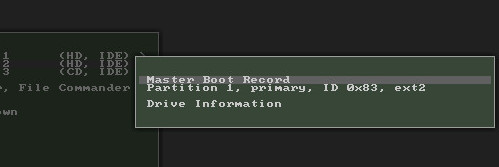
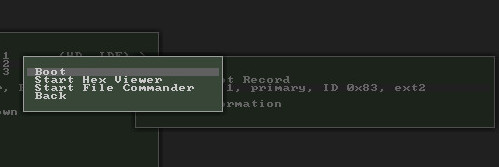
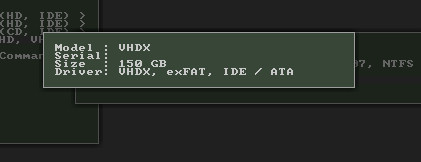
3.3. Configuration file
Details coming soon.
3.4. Configuration through kernel command line
Details coming soon.
3.5. Viewer
The Viewer can be used for drives, partitions and files. For drives and partitions, the viewer is locked to the hex view. There is a simple autodetection for files to set hex view for binary files and text view for text files. You can switch the view with the key F4.
Keys:
- Navigation: Up, down, page up, page down, home (pos 1), end
- Leave: 'q', F3, ESC
- Switch hex/text view: F4
File Text View, Hex View
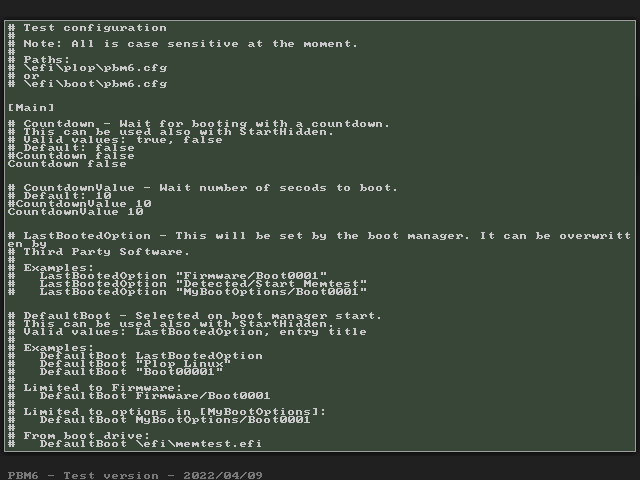
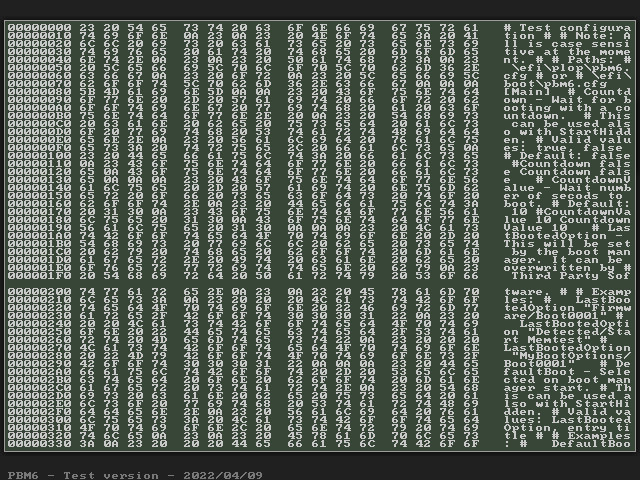
Drive Hex View - MBR
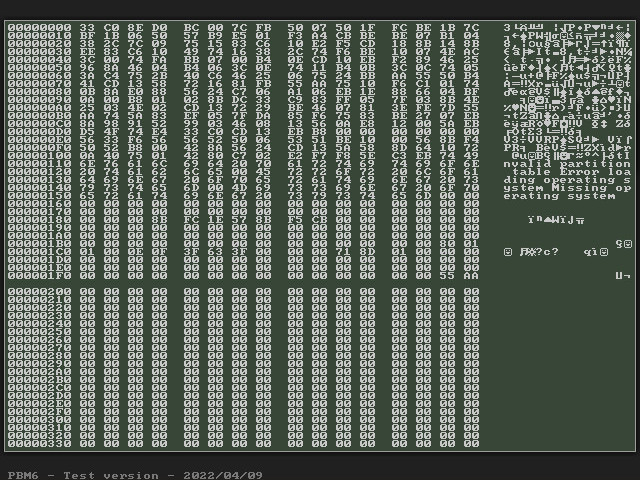
3.6. File Commander
You can navigate through supported file systems, view files and mount VHD/VHDX files.
- Supported file systems: FAT12/16/32, extFAT, NTFS, ext2/3
- Leave: ESC
- View files: F3, 'v'
- Enter on VHD/VHDX files: Show details, mount, view as hex
More features are planed.
File Commander showing a directory, on NTFS
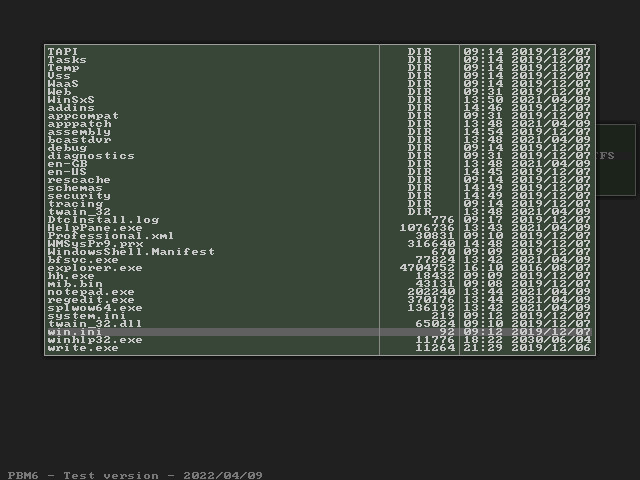
File Commander showing VHD and VHDX files, on exFAT
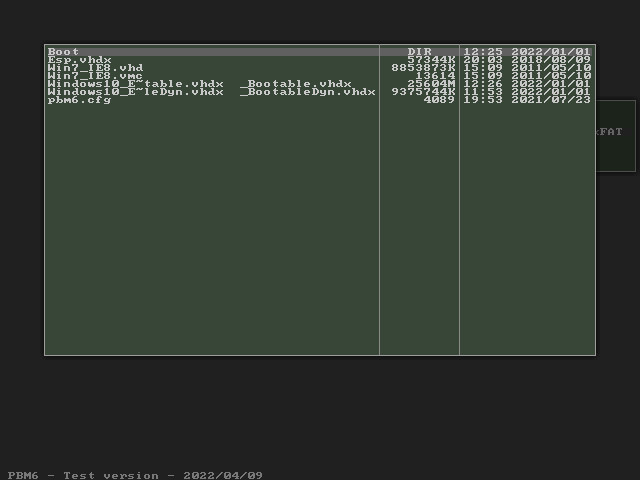
3.7. VHD/VHDX
Dynamic and fixed size images are supported. You can view image details with the File Commander and also mount the images. Mounted images are listed in the Main Menu and can be used like any other boot option.
VHD Image Details, VHDX Image Details
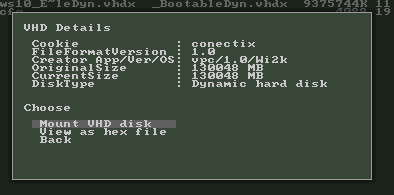
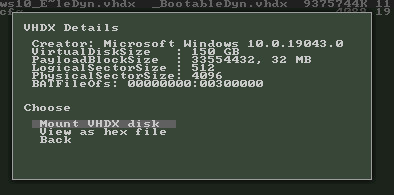
Main Menu with mounted VHDX Image, driver details
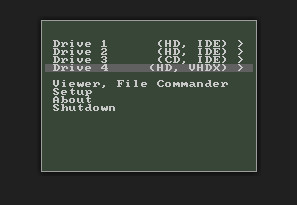

Video: VHDX Win10 Boot Test Jan/2022
4. PC Speaker
PBM6 has PC Speaker support for a simple screen reader and notifications. This will help blind and visually impaired people to use the boot manager. The Morse Code is used for the text.
There is a sound notification when the boot manager is ready to use.
In the main menu, you hear a short information with two chars. For boot entries, the first char is the drive type and the second char is the bus type. Example: Hard disk IDE is HI. CD-ROM SATA is CS. Hard disk USB is HU.
Static menu entries: Setup is SE. About is AB. Shutdown is SH.
With a hotkey, you hear the whole text of the menu entry.
Attaching and removing an USB drive gives a notification sound.
The PC Speaker feature will be available in the next Test Version.
Use CTRL-F5 to enable/disable the PC Speaker support. Pressing F5 will beep the current text as Morse Code.
Demonstration video
External content blocked. Watch on YouTube
Download as MP3: pbm6-pcspeaker.mp3
Download as text: pbm6-pcspeaker.txt
5. pbm6-dos.exe
pbm6-dos.exe is a DOS program to start PBM6. You can also start PlopKexec or a Linux Kernel.
What can you do?
- You can start PBM6 from DOS and chainload an OS from HDD, USB, CD and so on.
- You can start a Linux kernel from DOS.
- You can start PlopKexec from DOS.
- And more...
You can use the program with some parameters.
Parameters:
/? This help.
/v Print program version.
/d Debug mode.
/e <file name> Write loader to file.
/k <file name> Load Boot Manager or Linux Kernel.
/i <file name> Load initrd file.
/a <parameters> Append, parameters for the boot manager / kernel. Use " here for
multiple parameters.
/s xxxx Load real mode loader to segment (hex). Example: /s 9000
/d: Some debug information.
/e <file name>: Extract the loader. You can append another program to the loader.
pbm6-dos /e ldr.exe
Attach a new program in DOS:
copy ldr.exe+pbm6 newpbm6.exe
PlopKexec:
copy ldr.exe+plopkexec plpkexec.exe
Or a Linux Kernel:
copy ldr.exe+bzImage linux.exe
| Prev Table of Contents - Plop Boot Manager Six - PBM6 |
Table of Contents | Next PBM6 - EFI |
© 2025 by
Elmar Hanlhofer